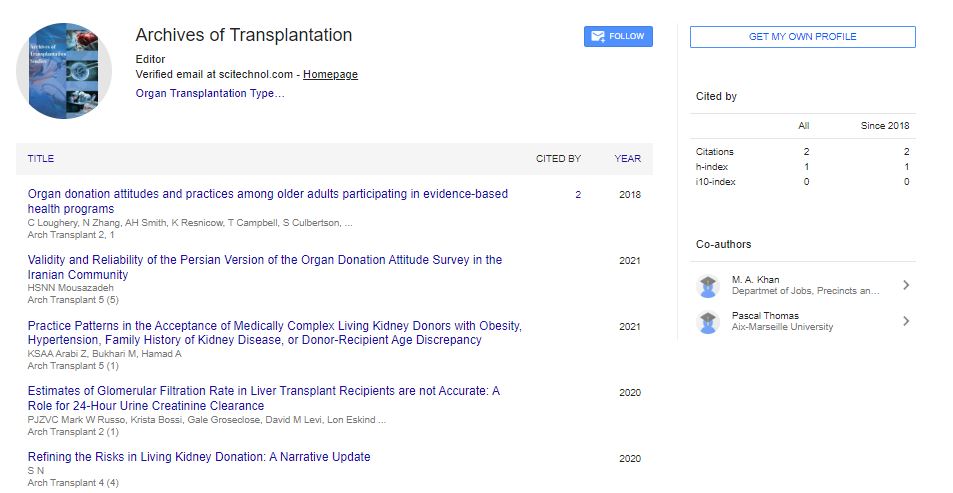Commentary, Arch Transplant Vol: 5 Issue: 5
Enhancing the Clinical Utility of Circulating Tumor Archives of Transplantation
Nicolas Mermod*
Institute of Biotechnology and Department of Fundamental Microbiology, University of Lausanne, Lausanne, Switzerland
*Corresponding Author: Mermod N, Institute of Biotechnology and Department of Fundamental Microbiology, University of Lausanne, Lausanne, Switzerland, Email: nicolas.mermoad@unil.ch
Received date: September 01,2021; Accepted date: September 15,2021; Published date: September 23,2021
Keywords: Biomarkers of Allograft
Introduction
Doctors have since a long time ago thought to be the transplantation of tissue and organs to people with different pathologies to be the Holy Grail. At first they were confronted with specialized issues, for example, keeping up with feasibility in organs eliminated from givers and anastomosing veins. Despite the fact that transplantation of generally avascular tissue cornea was fruitful, the exchange of vascularized organs among benefactors and beneficiaries who were not hereditarily indistinguishable regularly fizzled. Further investigations uncovered that these antigens are coded for by qualities in the significant histocompatibility complex. The dangerous response includes enactment of T lymphocytes in the beneficiary. Since the primary fruitful transfer of a kidney between indistinguishable twins in 1954, transplantation has advanced from being an exploratory technique to a routine clinical treatment offering enormous advantages for patients with organ disappointment. Notwithstanding, the endurance of relocated organs stays restricted by the body's safe reactions, and large numbers of the entanglements of transplantation result from the rough idea of our endeavors to smother these. This part clarifies how the endurance of relocated organs stays restricted by the body's safe reactions, which are intended to segregate among 'self' and 'non-self' or 'changed self', and the number of the complexities of transplantation result from the rough idea of our endeavors to smother these. Kidney transplantation is the favored methodology for renal substitution treatment in youngsters, however long haul allograft endurance remains imperfect and is restricted by progressing and quiet immunologic and non-immunologic injury measures. This is particularly significant in kids, who have longer expected life expectancy than grown-ups and are at higher danger of dismissal because of more prominent immunologic reaction in early ages and to a higher pace of non-adherence during immaturity and youthful adulthood. There is a huge requirement for approved methodologies for post-relocate observing in youngsters that can foresee early dismissal to work with protected and viable individualization of immunosuppressive treatment to diminish hazard of contamination, drug harmfulness, and unite injury and at last further develop long haul join endurance. In this section, we survey the writing on ordinary clinical, immunological, and histological markers utilized for postkidney relocate observing in youngsters. We additionally consider different arising sub-atomic biomarkers that seem to play a promising part in the immunologic observing and hazard separation of unite misfortune post-relocate. With every one of the complicated issues of acknowledgment or dismissal of a relocated organ, immunology is a vital subject for all transplantation clinicians. During ingoing years, there has been a blast of examination and information around here. Delivered in relationship with the American Society of Transplantation, and composed by specialists inside the field, Transplant Immunology gives a thorough outline of the theme according to clinical transplantation. Beginning with the fundamental usefulness of the invulnerable framework, it then, at that point continues on to cover the extremely most recent advancements in immunosuppressive medications and conventions, just as a gander at all arising innovations in the field. Key parts include: Transplantrelated confusions Immune reactions to transfers Emerging issues in transplantation Biomarkers of Allograft dismissal and resistance T cells and the standards of safe reactions In full tone all through, more than 100 extraordinary outlines support the message, all figures being completely downloadable by means of the book's buddy site. The outcome is a fundamental device for every one of those liable for overseeing patients anticipating and going through organ transplantation, including transfer specialists and clinicians, immunologists and scientists. The 20th century started with consistently ineffective undertakings at investigational allotransplantation, and the following 50 years was set apart by rehashed disappointment. The acknowledgment of histocompatibility antigens and the essential job of lymphocytes in allorecognition were the two advancements that established the framework of relocate immunology that was to ultimately shape the reason for systems prompting fruitful strong organ transplantation.
 Spanish
Spanish  Chinese
Chinese  Russian
Russian  German
German  French
French  Japanese
Japanese  Portuguese
Portuguese  Hindi
Hindi 